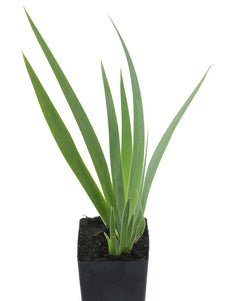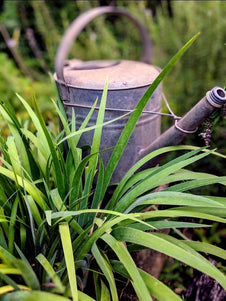



Orris Root
Orris Root

- In stock, ready to ship
- Inventory on the way

Usually available: All year
Life cycle: Perennial
Height: 50cm
Position: Full sun
Soil preference: Moist / well drained
This is how we pack and send your Herb Plants to all states except TAS & WA
You will receive
- 1 Orris Root Herb Plant in a 50 X 75mm tube - General growing instructions
All of our Herb Plants are grown organically with certified organic potting mixes and fertilizers
Botanical Name:
Iris germanica var. florentinaOrris root is a rhizomatous perennial with stiff, grey green and sword like leaves. Also known as the Florentine Iris, it grows to a height of approximately 50 cm and may spread up to 40 cm wide. The distinctly veined leaves emerge from the rhizomes, growing in a fan shape. The flowers appear in spring or summer and have the typical iris, flag like appearance as the three petals or ‘standards’ hang or droop downwards. These are joined by three outer petal-like sepals, called ‘the falls’. They are generally white, but may have a slight mauve or blue flush to them, with a yellow centre.
There are over 200 species in the iris genus and they grow in many environments, from the very cold to the very wet or the very dry. The iris genus is generally native to the northern temperate regions of the world and the Florentine iris is native to the southern regions of Europe. Over many centuries, the Florentine iris has been naturalised to Central Europe, Iran and northern India. It tends to favour the mountainous slopes, wherever it is sunny enough to grow.
The white Florentine Iris was cultivated in Florence in the early Middle Ages. Its place in history is secure and even today it may be found on the city’s heraldic coat of arms. According to Greek mythology, Iris was the goddess of the multi-coloured rainbow, which she used to travel across the sky in her role as Goddess of messages, communication and new endeavours. There is suggestion that this name was chosen for her because of the multi-coloured nature of iris flowers. However, others suggest that the plant was named in honour of the rainbow goddess. The Iris was also the floral emblem of a number of French monarchs. The word ‘orris’ is simply an old English word, derived from a mistaken pronunciation of the word Iris.
The root of this plant has a distinct violet fragrance, which develops as the root dries out. It is often used as a powdered preparation and has extensive commercial applications. The scented orris root has a long history of human application and was used as a perfume in Ancient Egypt. There is a flower engraved into the Sphinx, which is thought to be an iris. In the latter part of the 15th century, it was used together with anise as a scented powder blend to scent linen. Moving into the 18th century, it was put to good use as a hair powder and charged with keeping highly decorated hair styles in place.
Today, the iris is a much loved garden plant and is often planted en masse to create an impact. However, the value of the scented roots is still high and the plant is cultivated commercially for use as various types of perfume.
Growing Conditions
Orris root is best suited to cooler conditions, but it may be grown in warmer areas as long as it is not excessively hot, wet and humid in summer. They require full sun and it is important to keep the soil evenly moist, in rich, well-drained soil. Care should be taken not to use to much organic matter because this iris does not like too much nitrogen and prefers an alkaline soil. Avoid clay soils and wet ground.
The plant takes 2-3 years to mature and should live up to 10 years. It grows by division and may be propagated by lifting the plant and cutting the creeping rhizomes into sections. Make sure each section has its own fan of leaves and a growing point. The old centre section of the clump that has flowered should be discarded, since it will not flower again. Cut the leaves crosswise and replant them 35cm apart. Cover with soil and leave half the rhizome above ground level so they do not rot.
To harvest the plant, dig out the root in early summer and cut into small segments. After drying them in the sun the pieces may be stored in an air tight jar in the fridge. The fragrance of the root does not develop until a year after drying and continues to increase in fragrance. After 5 years the dried root will be at its most fragrant.
Medicinal Uses
Orris root has a history of medicinal use, but this has been surpassed by improvements in modern medicine. It was traditionally used for coughs and chest complaints, as well as for treating digestive complaints. Today it is rarely suggested, because there are much more useful herbal and conventional treatments.
Other Uses
The orris root is used mostly for its ability to impart a violet scent to potpourris and other dried material. It can also act as a preservative in dried material by working as a fixative and stabiliser for the scents in potpourri. The dried root powder may also be a useful talcum powder and dry shampoo. However, care should be taken as it may cause sneezing and coughing.
All information provided on this website is for informational purposes only. Please seek professional advice before commencing any treatment.





